Contents
Late grape varieties ripen in autumn, when the fruit and berry ripening season comes to an end. They are characterized by a long growing season (from 150 days) and a large amount of active temperatures (more than 2800 °C). Harvest begins at the end of September.
Late ripening grapes have their advantages and disadvantages. The main plus is the ability to use berries for homemade preparations. The disadvantage is the susceptibility of plants to frost and disease.
Late ripening varieties are not recommended for planting in the northern regions. In cold climates, berries often do not have time to ripen.
The best technical grades
Technical late grape varieties contain a lot of juice in the pulp. Such plants are unpretentious to growing conditions. To obtain a high yield, the bushes are cared for.
Isabel
Late Isabella grapes have technical and table uses. It is distinguished by large three-lobed leaves and cylindrical clusters weighing 140 g. The fruits are oval or round, black in color, on a strong skin there is an abundant wax coating. Pulp with a rich aroma of strawberries.
The maturation of Isabella takes from 150 to 180 days from the beginning of the growing season. The bushes are powerful and vigorous. Late Isabella grapes are resistant to phylloxera and fungal diseases.
When growing Isabella, it is important to prune the shoots in a timely manner. With high thickening, the fruits ripen unevenly and lose their taste. Berries are used fresh or for making wine.
Photo late grape variety Isabella:
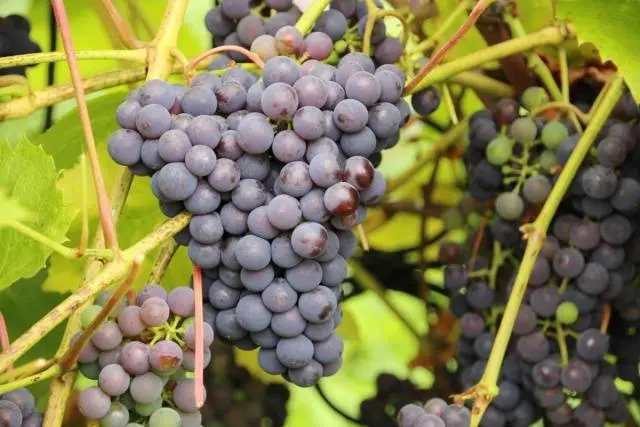
White Muscat
Muscat white grapes are an ancient variety of late fruiting, from which sweet dessert wines are made. The characteristic features of the plant are leaves with pointed tips, dense lobed clusters, berries with a wax coating.
The weight of a bunch is on average 110 g, for the largest – 450 g. The berry is round in shape with a yellowish tint. The pulp is tender, there is a nutmeg aroma. The berry contains about 2-3 seeds.
Muscat white has low winter hardiness, in spring the inflorescences suffer from frost. Harvest is removed after 140 days from the beginning of the growing season.
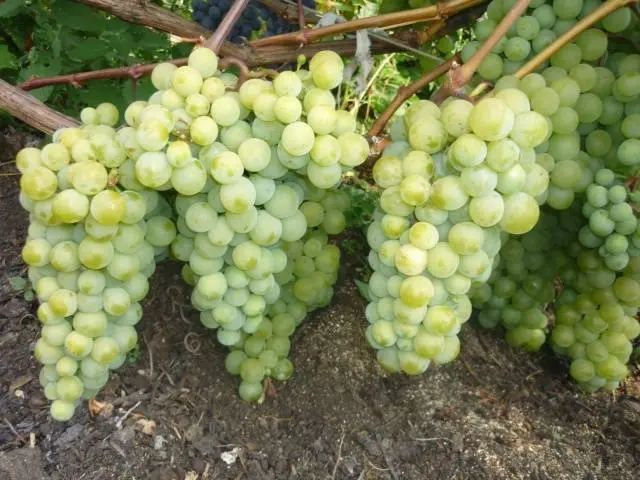
Merlot
Merlot grape is a French late variety that ripens in 152-164 days. The leaves are rounded, medium-sized. Clusters of cylindrical shape, weighing about 120 g.
The berries are black, rounded. The skin is strong, covered with a wax coating, the pulp is juicy with white juice. Wines from Merlot have a full and harmonious taste.
Merlot brings a late stable harvest. Bushes are resistant to mildew, rot and low temperatures. Occasionally there is a pea of berries.
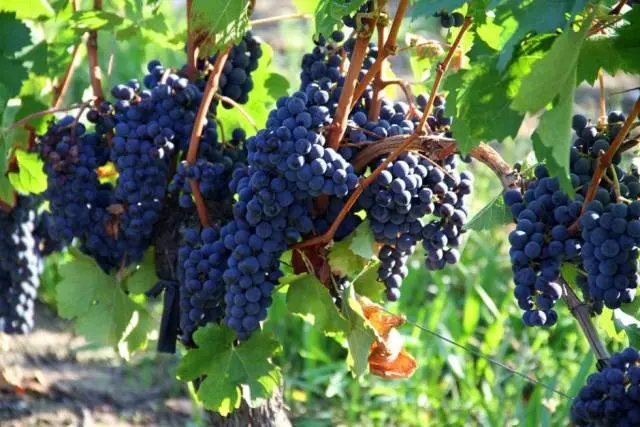
Lydia
Late Lydia grapes have both technical and table purposes. Variety imported from North America. Lydia is characterized by large rounded leaves. Clusters conical, small, loose.
The berries are round, saturated red, have a waxy coating of lilac hue. Fruit ripening occurs in 158 days. Ripening of shoots at a high level in both warm and northern regions. Up to 40 kg of berries are removed from the bush.
In warm climates, Lydia winters without shelter. The variety responds positively to top dressing. Pruning and pinching helps to avoid thickening of the bush.
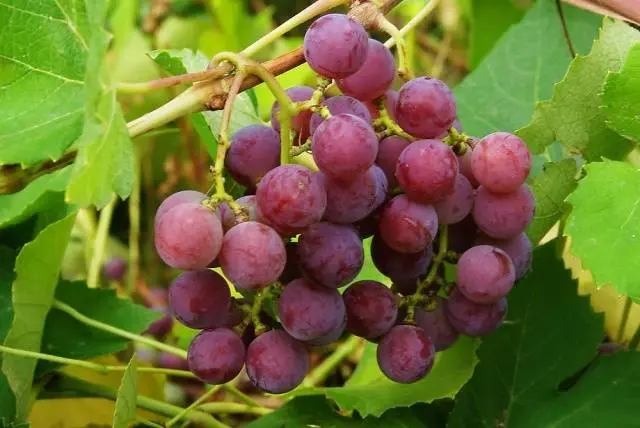
Saperavi northern
Northern Saperavi grapes ripen in mid-late time. The period from bud swelling to harvest is 141 days. It is used to make table wine and blended juice. Saperavi wine is characterized by high astringency and grassy notes.
The clusters are cone-shaped, small in size, rather loose. The fruits are small, oval, deep blue in color. The pulp contains a lot of juice, the skin is dense with a thick coating, the taste is harmonious and simple. The juice is bright pink, very thick.
Saperavi is highly resistant to winter frosts, but does not tolerate drought well. Harvest is normalized by pruning shoots.
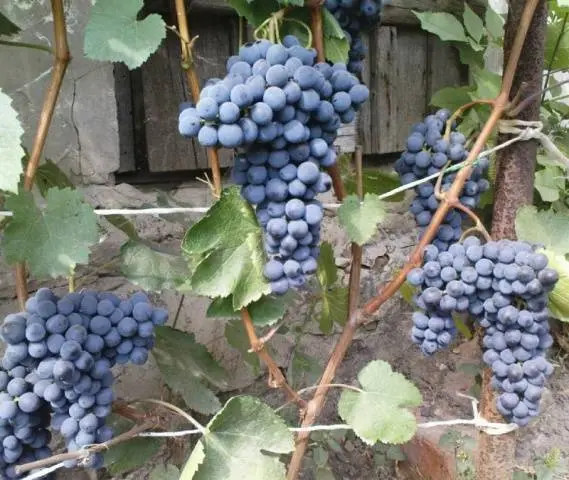
Cabernet Sauvignon
A late French grape variety intended for making wine. The clusters are not large, the berries are 15 mm in size, dark blue in color and round in shape. The peel is strong, covered with a thin layer of wax. The pulp is very juicy, the juice is clear.
To make wine, the clusters are removed 150-165 days after the start of the growing season. Cabernet Sauvignon is a late and winter-hardy variety, but it is prone to shedding of ovaries. In drought, the fruits become smaller. The accumulation of sugar occurs even with an increased load of the bush.
Cabernet Sauvignon grapes have good resistance to fungal infections. The variety successfully resists phylloxera and leafworm.
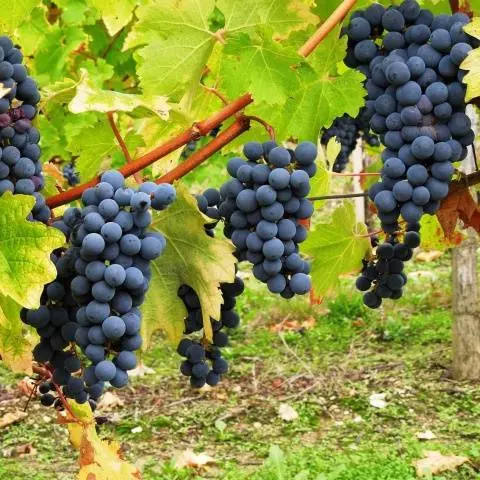
The best table varieties
Table late grapes are intended for fresh consumption. Clusters and berries have excellent commercial and gustatory qualities, they tolerate transportation well. Table varieties have thin skins, fleshy flesh and few seeds.
Moldova
Moldova is a table variety of medium-late ripening. Moldova grapes are characterized by large leaves and conical clusters. The mass of bunches is from 400 g to 1 kg. The flesh is crispy and fleshy. The fruits are oval, deep purple, covered with a thin layer of wax.
Moldova has great growth power. With thickened plantings, the presentation and taste of berries are lost. For the variety, long pruning is practiced. Up to 150 kg of berries are removed from adult bushes.
The culture prefers nutritious moist soils. Winter hardiness is average. To protect against diseases, 1-2 treatments per season are required. Moldova is valued for its good transportability.
Photo of late grape variety Moldova:
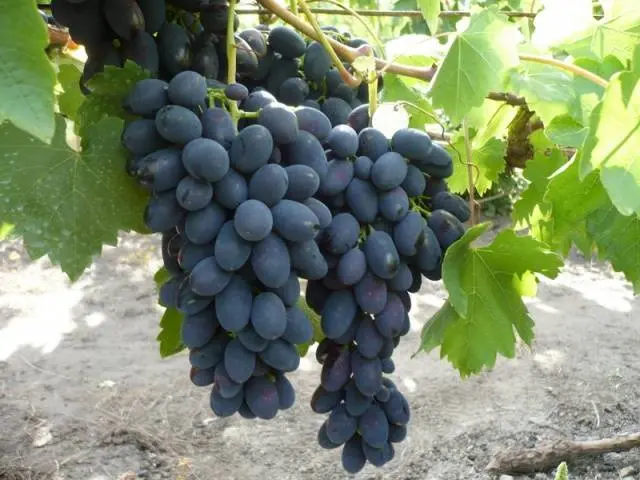
Asma
Asma is a Crimean late variety that yields in 160 days. Harvest from the vine is removed in mid or late October.
The plant is characterized by large rounded leaves with sharp tips. Clusters are large, in the form of a cone or cylinder, medium density. The mass of the bunch is about 350 g. The fruits are large, purple in color and oval in shape, with a small coating of wax on the skin.
The late variety Asma grows well in gravel soil, well warmed by the sun. For shoots, short pruning is used. Bushes are suitable for decorating arbors. Bushes have low winter hardiness.

Anuta
Anyuta grapes are a hybrid form that was bred by amateur breeder V.N. Krainov. Ripening occurs in the middle late periods. In the conditions of the Rostov region, the crop is harvested at the end of September.
Bushes grow rapidly after planting. Clusters in the form of a cone, weighing from 700 g to 1,2 kg. The density of clusters is average, commercial qualities are at a high level.
The fruits are large, oval, weighing 12 g, dark pink. The pulp is high in juice, the skin is dense. Light nutmeg notes are felt on the palate. The yield of the late variety Anyuta is high; for this, the number of ovaries on the shoots is normalized. Bushes must be covered for the winter.
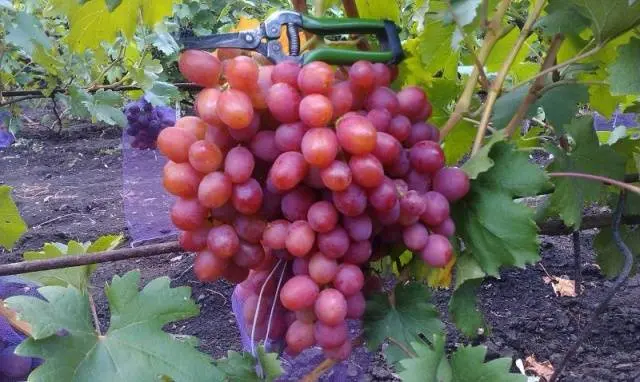
Odessa souvenir
Grapes bring a stable high yield. Clusters of medium and large sizes, loose, conical in shape, up to 20 cm long and about 12 cm wide.
The berries are large, oblong, up to 29 cm long and 12 cm wide. The color is black, there is a thick wax coating on the skin. The taste is distinguished by muscat-thorn notes. The fruits contain 3-4 seeds.
This is a late ripening grape variety, harvesting occurs 142 days after bud swelling. Harvesting is done at the end of September. Bushes are vigorous and powerful.
Odessa souvenir has good resistance to gray mold and mildew, but requires protection from oidium. Frost resistance is low, so in autumn the vine is covered for the winter.

December
Variety December – table black grapes, ripening late in 165 days. Grapes are resistant to fungal diseases that develop in high humidity. Bushes are not susceptible to phylloxera and leafworm. Winter hardiness is increased, plants tolerate a drop in temperature to -27 ° C.
Clusters of medium density, weighing 220 g. Fruits weighing 3 g. Leaves are oval, three-lobed, medium in size. The taste is harmonious and simple. Vine maturation at a high level.
The fruits are of high commercial quality, however, during long-term transportation, they fall off the brush. Harvest is stored in the refrigerator for a long time. The late variety December is suitable for industrial cultivation.

In memory of Negrul
In memory of Negrul – a late ripening grape variety obtained in Moldova. Bushes are immune to fungal diseases. The variety rarely suffers from phylloxera and other pests.
Grapes of the Memory of Negrul are distinguished by good frost resistance. The vine is covered in a snowless winter. Shoots need long pruning.
Bushes quickly grow green mass. The flowers are bisexual and do not require a pollinator to form the ovaries. The yield is high and stable. With prolonged rains, cracking of berries is observed.
The average weight of a bunch is 350 g, the size is 12×20 cm. The bunches are loose and loose. The berries are black, weighing 5-7 g, the taste of the pulp is simple. In memory of Negrul has a presentation, it is stored in the refrigerator for a long time.

Conclusion
When choosing a late grape variety, the characteristics of the region are taken into account. These varieties are suitable for growing in warm climates. In cold regions, berries do not always have time to ripen. Late grapes are represented by table and technical varieties.
Some can be consumed without processing or sent to the preparation of wine drinks. Late varieties are used for planting in gardens, as well as for industrial cultivation. Most of them are resistant to diseases, cold snaps and pests.









